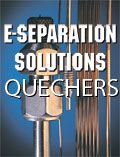The Gulf Oil Spill: Labs Unite to Solve Analysis Problems
LCGC recently interviewed Walter J. Krol, Ph.D., of the Connecticut Agricultural Experiment Station (New Haven, Connecticut) about his laboratory?s involvement in analyzing samples from the 2010 Deepwater Horizon oil spill in the Gulf of Mexico using a QuEChERS-based method.
LCGC
recently interviewed Walter J. Krol, Ph.D., of the Connecticut Agricultural Experiment Station (New Haven, Connecticut) about his laboratory’s involvement in analyzing samples from the 2010 Deepwater Horizon oil spill in the Gulf of Mexico using a QuEChERS-based method.
At EAS this year, you gave a talk in which you discussed your laboratory’s involvement in analyzing seafood, following the 2010 Gulf oil spill, using QuEChERS. Why did your laboratory in Connecticut get involved in that project?
Krol: The Connecticut Agricultural Experiment Station (CAES) became involved in analyzing samples for the Deepwater Horizon Oil Spill owing to the fact that it is a Chemistry Cooperative Agreement Program (c-CAP) lab in the Food Emergency Response Network (FERN). When it was determined that the NOAA method was unfeasible for the testing of the thousands of potential samples expected as a result of the spill, the Food and Drug Administration (FDA), and more specifically the FERN group of labs, was called upon to develop alternative screening methodology with the FDA lab being the point lab. The Connecticut lab and the Minnesota labs were called upon by the FDA FERN headquarters based in Cincinnati, Ohio, to help codevelop an alternative QuEChERS (quick, easy, cheap, effective, rugged, and safe)-based screening method for the analysis of seafood, owing perhaps to the prior expertise that these labs had employing the QuEChERS method.
Can you tell us about what went into developing and implementing that method for that particular project?
Krol: From the outset, the methodology was to be QuEChERS-based. It is a method that most labs could implement without much lead-time owing to its simplicity. It was determined that analysis would be by high performance liquid chromatography (HPLC) with fluorescence detection, as it was felt that the equipment used in this analysis also would be available in a high proportion of labs. The original goal was to put a robust method in place as rapidly as possible using equipment that was widely available. In the event that enormous numbers of samples required analysis as many labs as possible could be called in to perform the analysis.
The biggest challenges in the work were: 1) dealing with instrumentation that was being controlled by outdated Windows NT software and 2) time. In the time period from June 9, 2010, when the FDA was told to develop the screen, and July 26, 2010, when a validated method was posted on the FDA website, time was a critical factor. Staff at CAES put in a lot of overtime in this period helping to determine the most efficient manner to extract the seafood samples; determine the best and most sensitive method for the analysis; actually run the spiked samples through the instrument (almost 4 days of running samples alone); process the data (manual integration of almost 2500 individual peaks); and put together data packages acceptable to the FDA.
Has that project had any impact on how you apply QuEChERS for other types of samples?
Krol: CAES has been working with the QuEChERS method since 2006, and has great familiarity with it. Since 2006, the CAES has been routinely using the method in the analysis of food samples as part of its annual surveys on pesticide residues in food. The use of the method has had a dramatic effect upon the results of the Connecticut surveys (which had been similar to the results of the larger FDA survey until its introduction in 2006). I am in the process of compiling a manuscript summarizing this work for submission to LCGC North America. CAES is also exploring the application of the QuEChERS method to environmental samples.
Were there any lessons you learned during that project that might help you or other laboratories working in future emergency response situations?
Krol: The best lessons learned from this work are the extent to which communication and teamwork can lead to a positive outcome. During the course of the work, teleconferences were held several times a week and emails were constantly being circulated. I suppose that the best lesson learned was that by putting together the right team of individuals a lot can be accomplished in a very short time span.
PFAS Analysis in Practice: A RAFA 2024 Interview with Stefan van Leuwen
January 10th 2025At the Recent Advances in Food Analysis (RAFA) conference in 2024, LCGC International sat down with Stefan van Leuwen of Wageningen Food Safety Research to discuss his research, which addresses emerging challenges in circular food production, focusing on the risks posed by pollutants when waste and by-products are repurposed in food systems.
Analyzing New Drug Modalities: An ISC 2024 Interview with Kelly Zhang
January 10th 2025At ISC 2024 in Liverpool, United Kingdom, LCGC International interviewed Kelly Zhang of Genentech about her work analyzing new drug modalities, such as mRNA, oligonucleotides, peptides, and cell and gene therapies.
Using Chromatography to Study Microplastics in Food: An Interview with Jose Bernal
December 16th 2024LCGC International sat down with Jose Bernal to discuss his latest research in using pyrolysis gas chromatography–mass spectrometry (Py-GC–MS) and other chromatographic techniques in studying microplastics in food analysis.
The Use of SPME and GC×GC in Food Analysis: An Interview with Giorgia Purcaro
December 16th 2024LCGC International sat down with Giorgia Purcaro of the University of Liege to discuss the impact that solid-phase microextraction (SPME) and comprehensive multidimensional gas chromatography (GC×GC) is having on food analysis.
